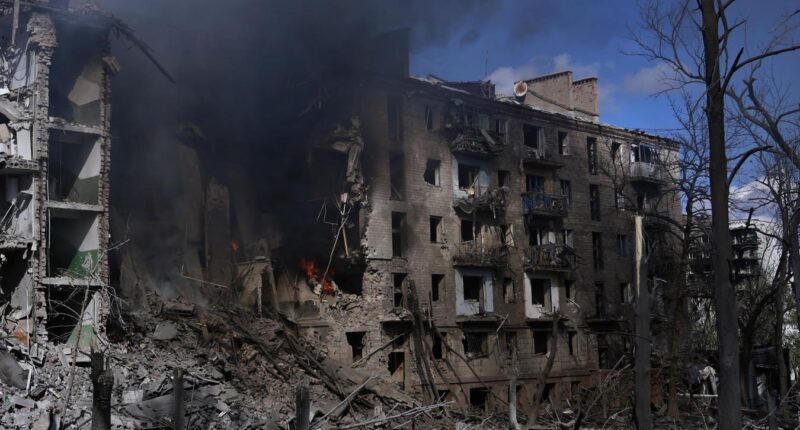Share this @internewscast.com
KOSTIANTYNIVKA, UKRAINE – OCTOBER 12: Fire and smoke rise from partially ruined residential building after Russian shelling on October 12, 2025 in Kostiantynivka, Ukraine. (Photo by Yan Dobronosov/Global Images Ukraine via Getty Images)
Global Images Ukraine via Getty Images
Dispatches from Ukraine. Day 1,329.
In the early hours of Oct. 10, Russia launched its third large-scale aerial assault on Ukraine this month, with 465 drones and 32 missiles that primarily targeted the country’s energy infrastructure.
Ukraine intercepted 420 projectiles, including 15 missiles, while another four missiles failed to reach their intended targets. This marked the second direct hit on Ukraine’s power grid in October and left a trail of disruption akin to the first large-scale bombardment inflicted exactly three years ago.
Blackouts were particularly widespread following this attack. Nine regions, including Kharkiv, Sumy, and Poltava faced partial power outages; Ukraine’s capital Kyiv, meanwhile, endured the heaviest disruptions. Ukraine’s energy companies reported damage at multiple facilities, including two combined heat and power plants, two thermal power stations as well as four hydroelectric plants.
Over time, Russia’s large-scale attacks have evolved: these strikes now occur primarily under the cover of night and rely heavily on drones, whereas the initial strikes were carried out exclusively with missiles. This shift in Moscow’s tactics has prompted Ukraine to adapt its defense strategy. Rather than using chronically scarce air defense missiles against relatively inexpensive Russian drones, Ukraine is now deploying its own inexpensive “interceptor drones” to avoid depleting an already strained air defense system.
In an interview with Fox News on Oct. 12, President Zelenskyy said that these interceptors are currently operating at a 68% interception rate. “These drones are the most cost-effective way to neutralize Iranian-designed [now Russian-produced] ‘Shaheds,’” he added.
Zelenskyy also said that the main obstacle to scaling production comes down to scarce financial resources: private manufacturers lack sufficient funding to expand output. He estimated the cost of a single interceptor drone at $3,000–$5,000. Estimates for the Russian Shahed drone, in turn, range from $20,000-70,000 per unit, though it is difficult to pinpoint the exact cost as it varies depending on the size of the batch produced.
In parallel, in the aftermath of the Oct. 10 attack, President Zelenskyy voiced frustration over the protection of Ukraine’s energy infrastructure. Without divulging specific details, he said that these facilities are defended on multiple levels, citing three tiers of protection. He added that adverse weather conditions this time “reduced our interception by roughly 20-30%.” Zelenskyy described the Russian strike as “powerful, but not lethal,” and noted that Moscow has deployed more than 3,100 drones and almost 100 missiles against Ukraine since Oct. 5.
In addition, Ukrainian officials reported 25 people killed and some 85 others injured in Russian strikes between Oct. 10 and 13. Eastern Donetsk oblast, or region, reported the highest toll, with 11 non-combatants killed and 24 others wounded. Southeastern Zaporizhzhia oblast saw six civilians killed and 22 injured, followed by central Dnipropetrovsk with four deaths and 11 injuries. Southern Kherson province recorded three killed and 20 wounded, while northeastern Kharkiv oblast reported one fatality and 12 injuries.
Ukraine Delegation to the U.S.
President Volodymyr Zelenskyy will meet with President Donald Trump at the White House on Friday, Oct. 17. The visit was confirmed by multiple officials, including Ukraine’s ambassador to the U.S., Olga Stefanishyna, who assumed her post in late August. Zelenskyy’s arrival will conclude a trip to Washington this week by a delegation of senior Ukrainian officials, led by Prime Minister Yulia Svyrydenko, who have already departed for the U.S.
The talks come as President Trump has indicated that his administration is considering the transfer of long-range Tomahawk missiles to Ukraine, calling such a move “a new step of aggression” in the war against the Kremlin. Speaking on Air Force One on Oct. 13, Trump added, “We may not, but we may do it. I think it’s appropriate to bring up.” He also told reporters that he and Zelenskyy spoke about the possibility of Ukraine obtaining Tomahawk missiles over the weekend by phone. Presidents Trump and Zelenskyy spoke twice, on Oct. 11 and 12, also discussing Ukraine’s air defenses and energy security in the wake of Russia’s recent strikes.
The proposed delivery of Tomahawk missiles represents a potential escalation in U.S. support for Ukraine. It would allow Kyiv to reach Moscow with particularly destructive weapons. Officials in the Kremlin are watching with concern. In particular, Russian President Vladimir Putin warned that such a transfer would mark a “qualitatively new stage of escalation, including in relations between Russia and the U.S.” Dmitry Medvedev, former president of Russia, also cautioned that the move “could end badly for everyone, and first and foremost, for Trump himself.”
By Danylo Nosov, Karina L. Tahiliani












